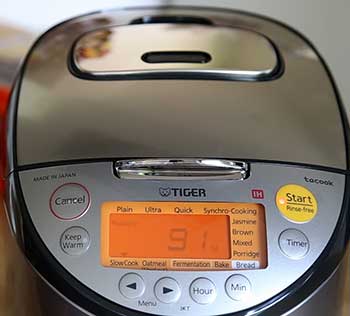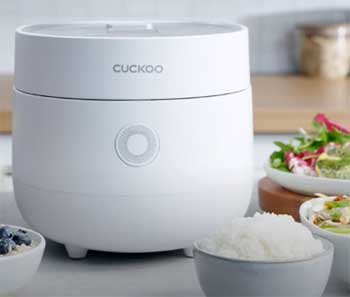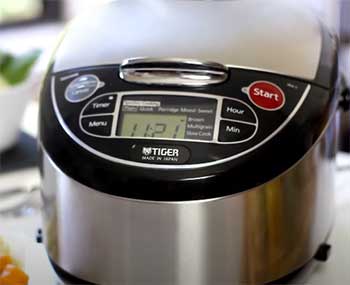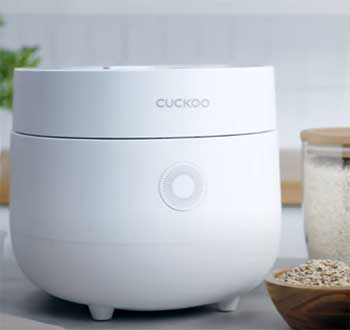Rice is a staple food for many cultures around the world. Having a reliable rice cooker in your kitchen can make cooking fluffy, delicious rice effortless. Two of the most popular brands of rice cookers are Tiger and Cuckoo.
But which one is better?
In this comprehensive guide, we’ll compare the key features, performance, durability, and price of Tiger and Cuckoo rice cookers. Keep reading to find out which brand comes out on top.
A Brief Comparison Table
| Feature | Tiger | Cuckoo |
| Price Range | $100 – $500 | $200 – $600 |
| Popular Models | JKT-S10U, JNP-1800, JBU-Y10 | CRP-G1015F, CR-0631F, CRP-P1009S |
| Capacity Range | 3 – 22+ cups | 2 – 20 cups |
| Inner Pot Material | Aluminum, stainless steel, ceramic | Stoneware, stainless steel, cast iron |
| Heating Technology | Basic, fuzzy logic, induction | Basic, fuzzy logic, pressure cooking |
| Rice Texture | Good | Excellent |
| Durability | Very good | Excellent |
| Ease of Use | Very easy | Very easy |
| Extra Functions | Pressure cooking, slow cooking, sautéing | Steaming, stewing, baking, fermenting |
| Overall | Very good, wider range of budget models | Excellent, specialized high-end models |
A Brief History of Tiger and Cuckoo
First, let’s take a quick look at the origins and history behind these two iconic rice cooker brands.
- The Story Behind Tiger

Tiger Corporation is a Japanese multinational company headquartered in Tokyo, Japan.
They started producing rice cookers in the 1950s and released their first automated rice cooker, the JKT-1, in 1957.
This revolutionary appliance could cook rice automatically and keep it warm after cooking completed.
The JKT-1 was a hit, and Tiger went on to become one of the largest producers of rice cookers worldwide.
Fun fact – the name “Tiger” comes from the company’s logo, which features a tiger cub. This logo represents the founder’s wish for his company to always have a youthful, energetic spirit.
- The Beginnings of Cuckoo
Cuckoo Electronics Co. Ltd is a South Korean company founded in 1978. Their first rice cooker, the CR-0655F, debuted in 1984.
This model had fuzzy logic technology, allowing it to automatically adjust cooking time and temperature based on the rice type and quantity. The CR-0655F was a game-changer in the rice cooker industry.
Cuckoo eventually rose to become the #1 rice cooker brand in South Korea. Their innovative technology and stylish designs make them a popular choice worldwide.
Key Differences Between Tiger And Cuckoo Rice Cookers
Now that we’ve learned a bit about their origins, let’s see how Tiger and Cuckoo rice cookers compare today.
Rice Cooker Models and Design
Rice cookers come in a wide range of sizes, styles, and price points. Tiger and Cuckoo both offer extensive product lines with options tailored to different users.
Tiger Rice Cooker Models
Some of Tiger’s most popular current models include:
- JBV-A10U: 5.5 cup capacity, basic on/off function
- JKT-S10U: 10 cup capacity, fuzzy logic, keep warm
- JNP-1800: 10 cup capacity, pressure cooking and slow cooking functions
- JBU-Y10: 10 cup capacity, stainless steel exterior, induction heating
As you can see, Tiger has rice cookers suitable for individuals, families, rice connoisseurs, and anyone in between. They offer models with basic functions up to advanced pressure cooking and sautéing ability.
Cuckoo Rice Cooker Models
Well-known Cuckoo rice cooker models include:

- CRP-G1015F: 10 cup capacity, fuzzy logic, preset cooking menus
- CR-0631F: 6 cup capacity, pressure cooking, aluminum inner pot
- CRP-P0609S: 6 cup capacity, stainless steel finish,keep warm function
- CR-13G: 13 cup capacity, limestone inner pot, interchangeable melody
Cuckoo is celebrated for their stylish designs, like the popular Mini which has a cute miniature shape.
They also have many high-end models with specialized features tailored to Asian cooking.
When it comes to design, Cuckoo rice cookers often have a sleeker, more modern aesthetic. However, Tiger also offers some models with stainless steel finishes and minimalist details. Overall, both brands have attractive, well-designed models to choose from.
Size Options
Both Tiger and Cuckoo offer rice cookers ranging from 3-20 cups in capacity. Here is a comparison of some of their similarly-sized models:
- Small: Tiger JAX-T18U (3 cups) vs. Cuckoo Mini CR-0351F (2 cups)
- Medium: Tiger JBV-A18U (10 cups) vs. Cuckoo CR-0631F (6 cups)
- Large: Tiger JNP-S10U (10 cups) vs. Cuckoo CRP-P1009S (10 cups)
- Extra Large: Tiger JBV-A22U-W (22 cups) vs. Cuckoo CRP-CHSS1009 (20 cups)
As you can see, both brands give you plenty of versatility in terms of capacity. Tiger does have more ultra large options above 20 cups for the biggest batches of rice.
Rice Cooking Features and Performance
Now let’s compare some of the key rice cooking features between Tiger and Cuckoo.
Cooking Functions
The main settings you’ll find in both brands include:
- White rice
- Brown rice
- Quick cooking
- Porridge/congee
- Slow cooking
- Reheating
- Keep warm
However, Cuckoo rice cookers tend to have a few more specialized cooking functions tailored to Asian dishes like:
- Gaba rice (for germinated brown rice)
- Nu Rung Ji (scorched rice)
- Soybean paste stew
Tiger remains more focused on basic rice cooking. But some higher end models do have settings for making rice porridge, sushi rice, mixed rice, and more.
Inner Pots

The inner cooking pot is one of the most important components, as it directly contacts the rice.
Tiger typically uses thick aluminum with a non-stick coating.
Some models have a stainless steel pot or ceramic coating.
Many Cuckoo cookers feature specialized stoneware pots made of sand, germanium, clay, and other minerals.
These retain heat well and impart a rich flavor. Higher-end Cuckoos may use cast iron or stainless steel.
Heating Technology
Basic Tiger and Cuckoo models rely on simple on/off heating elements.
Mid-range to high-end models use advanced technology to fine-tune temperature during cooking:
- Fuzzy Logic: Adjusts heating patterns based on variables like rice type, quantity, etc. Commonly seen in Tiger and Cuckoo models.
- Induction Heating: Uses magnetic induction to generate precise heat. Found in some Tiger cookers.
- Pressure Cooking: Builds up high pressure steam to cook rice faster while retaining texture. Offered in high-end cookers from both brands.
Cuckoo tends to have more models with pressure cooking compared to Tiger. But Tiger has a wider range of induction heating rice cookers.
Rice Texture and Flavor
In terms of rice taste and texture, Cuckoo rice cookers are renowned for producing exceptionally fluffy, glossy rice with superior flavor. The mineral stoneware pots make a difference here.
However, Tiger also churns out tender and delicious rice. Models with fuzzy logic or pressure cooking can compete with Cuckoo in terms of rice quality.
So while Cuckoo may have a slight edge, Tiger also delivers outstanding results that will satisfy most users.
Durability and Reliability
No one wants to buy a rice cooker that breaks after a few months. How do Tiger and Cuckoo compare when it comes to durability?
Both brands manufacture their cookers with quality materials and advanced engineering. Their products are designed for years of steady use.
Tiger constructs their cookers with rigid, tightly-sealed lids and bodies. Models like the JNP-1800 have an impressive 9.5 mm thick inner pot that retains heat effectively.
Meanwhile, Cuckoo takes pride in rigorous durability testing. Their cookers can handle repeated use without performance decline. The CRP-CHSS1009 endured over 3,000 open/close tests without damage.
Consumer reviews indicate excellent longevity for both Tiger and Cuckoo. As long as you perform proper maintenance, these rice cookers should keep cooking for 5+ years or more.
In terms of reliability, Cuckoo does seem to have a slight reputation advantage. But in general, both brands produce solid and dependable rice cookers.
Also Read: Differences Between Zojirushi Micom And Neuro Fuzzy Rice Cookers.
Price and Budget
With advanced features and solid construction, Tiger and Cuckoo rice cookers fall on the pricier end of the scale. Let’s break down what you can expect to pay:
Tiger
- Basic models: $100 – $150
- Mid-range models: $150 – $300
- Advanced models: $300 – $500
Cuckoo
- Basic models: $200 – $300
- Mid-range models: $300 – $400
- Advanced models: $400 – $600
Cuckoo does trend more expensive overall. Their entry-level models start around $200, while basic Tigers can be under $100.
But Tiger’s most high-tech cookers overlap with Cuckoo’s premium price points. You can find advanced cookers from both brands in the $400 – $600 range.
Tiger offers a wider range of affordable options under $200. But Cuckoo focuses on higher-end materials and technology that justify their prices for serious rice aficionados.
Ease of Use and Convenience
Of course, a key factor for any kitchen appliance is how easy it is to use. Tiger and Cuckoo aim to make the rice cooking process as seamless as possible.
Most models from both brands have simple and intuitive control panels. Icons clearly indicate cooking functions, and settings are easy to program.
Helpful extras like delayed start, keep warm, and extended cook timers are common across both Tiger and Cuckoo. This allows flexibility in timing your rice.
Some Cuckoo cookers have melody options, letting you customize the jingle played when cooking completes. But otherwise, Tiger and Cuckoo have similar convenience features.
For easy cleaning, all parts detach and the inner pots have a non-stick coating. Both brands are simple to maintain day-to-day.
One difference is that some Cuckoo models support smart connectivity. You can control cooking and monitor your cooker from your phone. Tiger has yet to adopt app integration and smart technology.
Safety Features
Safety should also be considered when choosing any kitchen appliance involving heat and electricity. Here are some of the key safety features built into Tiger and Cuckoo rice cookers:

- Auto shut-off – Once rice is done, the heating element turns off automatically to prevent overcooking.
- Removable power cord – Allows you to unplug the cooker quickly in an emergency.
- Cool touch body – The outer body stays cool during cooking to prevent burns.
- Steam vents – Vents on the lid allow excess steam to release safely.
- Boil over prevention – Sensors prevent the pot from boiling over by adjusting heat as needed.
- Locking lid – The lid locks securely into place for safe pressurized cooking.
Both brands meet industry standards for electrical safety and durability testing. Following the included instructions will ensure safe operation.
Additional Functionality
So far we’ve focused on the core rice cooking capabilities. But Tiger and Cuckoo also offer appliances with extra functionality beyond just rice:
Tiger Multi-Cookers
- Pressure cooking
- Slow cooking
- Steaming
- Sautéing
- Making yogurt
Cuckoo All-in-One Cookers
- Steaming
- Stewing
- Braising
- Soup making
- Baking
- Fermenting
The programmable menus and versatility of these “smart” cookers let you prepare all kinds of one-pot meals. It’s like a rice cooker and electric pressure cooker in one.
While they require a higher budget, these multi-function appliances can be handy additions for whipping up a variety of dishes.
Tiger Or Cuckoo: Which Should You Buy?
Now that we’ve compared these two popular brands across a number of factors, let’s summarize the key differences:
Tiger
- More budget-friendly options under $200
- Slightly wider range of capacities
- Basic, no-frills models for just cooking rice
- More advanced models with pressure cooking
- Reliable but standard rice texture and flavor
- Functional, durable design but less modern aesthetic
Cuckoo
- Trend more expensive overall
- Stylish, contemporary design
- Specialized cooking functions for Asian rice dishes
- Superior rice texture and flavor in most models
- Slightly higher reputation for quality and durability
- More models with smart technology
For most home cooks looking for an affordable but dependable rice cooker, Tiger is an excellent choice thatcovers all the basics. Their mid-range fuzzy logic models offer great performance for under $200.
Cuckoo is ideal for rice aficionados who want top-tier rice flavor and texture. Their stoneware pots and specialized cooking menus justify the higher costs. Plus Cuckoo offers sleek, stylish designs.
Those are the key distinctions to consider when choosing between Tiger and Cuckoo. While Cuckoo takes the edge for premium quality, Tiger remains a reliable workhorse brand for home cooks on any budget.
Frequently Asked Questions (FAQ)
Still trying to decide between Tiger and Cuckoo? Here are answers to some common questions about these rice cooker brands.
While Cuckoo makes some of the best rice cookers available today, Tiger remains an excellent mainstream option. For shoppers looking for affordable reliability, Tiger gets the job done wonderfully. But Cuckoo excels when you want the pinnacle of rice cooking performance.
Yes, Tiger rice cookers are absolutely worth their reasonable price tags, especially mid-range models with fuzzy logic. You get proven cooking technology in durable, long-lasting machines. Tiger makes cooking fluffy rice easy for just about any home cook.
For cooking rice specifically, Cuckoo does edge out Tiger in overall quality and flavor. The specialized pots, precise heating controls, and cooking functions result in exemplary texture and taste. So Cuckoo is worthwhile for rice purists. But casual home cooks will find Tiger more than sufficient.
Some comparable alternatives to Tiger include Zojirushi, Panasonic, Aroma, Oster, and BLACK+DECKER. These brands offer similar capacities, settings, and price ranges as entry-level and mid-range Tiger models. Zojirushi in particular competes closely with Tiger.
For a high-end rice cooker alternative to Cuckoo, Zojirushi is again a top choice. Their Neuro Fuzzy Logic models match Cuckoo for technology and rice quality at similar price points. Users wanting max performance without the Cuckoo cost may also look at advanced Tiger models.
The Verdict: Tiger and Cuckoo Both Shine
When it comes to top-tier rice cooker brands, you can’t go wrong with either Tiger or Cuckoo. While Cuckoo edges into the lead overall, Tiger remains hot on its heels with more budget-friendly options.
No matter which you choose, following the manufacturer’s instructions and performing regular cleaning will give you years of perfectly cooked rice. Both brands deliver quality and reliability that justifies the investment.
The right choice comes down to your budget and priorities. For affordable excellence, Tiger has you covered. And if only the best rice cooking will do, Cuckoo models are the cream of the crop.
Whichever route you take, you’ll enjoy easier, tastier rice meals for your family.
